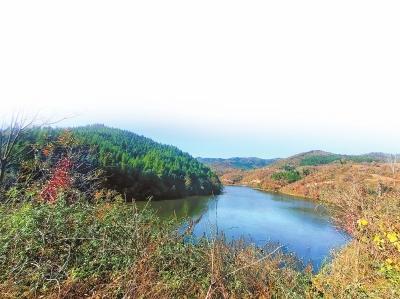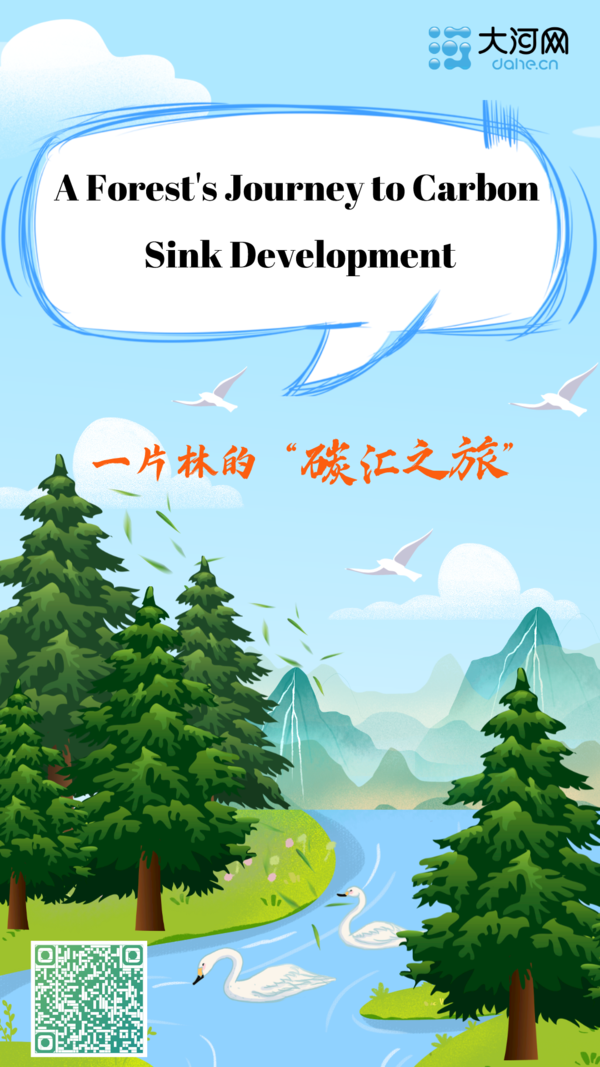Covering an area of 5,430 mu (1 mu equals to 0.067 hectares) in the Dabie Mountain range, I am a fir forest distributed in Wangchong village of Shawo town, Xinxian county, Xinyang city, Henan province. Thanks to the evergreen firs, I'm still verdant although it is winter now.
The fir forest inWangchong village. [Photo by Liu Xiaoyang for Henan Daily]
More than 10 years ago, the land where I was born was barren and overgrown with weeds. In 2009, organized by a local cooperative, over 400 villagers created me by planting fir saplings throughout the year.
Forestry experts say that the climate and soil conditions of Xinxian county are particularly suitable for my growth. Furs usually grow fast with straight shape and soft texture, thus enjoying a broad market. It is worth noting that with the country's carbon peaking and neutrality goals put forward, another unique function of me and my family—forest carbon sink—has been increasingly valued.
Carbon sink, which may sound unfamiliar, is actually like bank deposit. The difference is what we store is carbon dioxide instead of money. Plants usually absorb carbon dioxide through photosynthesis, but they cannot take in completely because part of it will be released as plants and soil breathe or by fires, pests, logging and their natural deaths. After deduction, the remaining is known as the carbon sink.
Statistics speak louder. According to a study published by the Chinese Academy of Sciences in 2018, China's terrestrial ecosystems sequestered 201 million tons of carbon dioxide annually between 2001 and 2010, equivalent to offsetting 14.1 percent of the country's fossil fuel emissions during the same period, of which about 80 percent of carbon sequestration were contributed by our forest family.
In recent years, our forest family keeps expanding. During the 13th Five-Year Plan period alone, a total of 13.38 million mu of trees were planted across Henan, with a forest coverage rate of 25.07 percent. Apart from natural carbon sequestration, my families worked together and contributed a lot to biodiversity protection, water conservation, windbreak and sand fixation, etc.
You might wonder how is the carbon sink traded? Wang Heguang, head of the cooperative, said, "Carbon sink trade is to 'set a price' on the ecological functions of forests. Enterprises or individuals can purchase forest carbon sinks through carbon trading platforms to neutralize their carbon dioxide emissions."
With great potentials, I became Henan's first carbon-sink forestry project that completed the whole project establishment process of the National Development and Reform Commission with the assistance of Wang Heguang and related forestry departments.
That is only the first step. A healthy, stable and efficient ecosystem with regular forest cultivation, banning illegal logging, prevention and control of forest diseases and insect pests can better increase my carbon sinks.
To increase my "value", the cooperative built a forest resource management and protection station with over 10 panoramic cameras installed, so as to monitor my growth through an app on their smart phones.
People in Wangchong village also care about me. At the critical moment of forest fire prevention, forest ranger Wang Xianshu and other villagers are stepping up their patrols to protect me from any fire threats.
The national carbon emissions trading market launched online trading in July this year, which is good news for me and the villagers of Wangchong. Hopefully, my carbon sinks will make money in the near future.
Looking ahead, China has set new targets to tackle climate change: China will increase the forest stock volume by 6 billion cubic meters from the 2005 level by 2030. It means that our forest family will play a more prominent role in achieving carbon neutrality. I cannot wait! (Chinese source: Henan Daily Reporter: Liu Xiaoyang Translator: Zhao Hanqing Poster: Wang Junyi Proofreader: Ding Lan)




